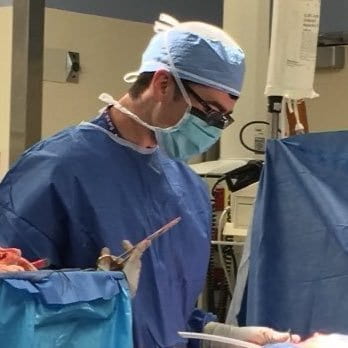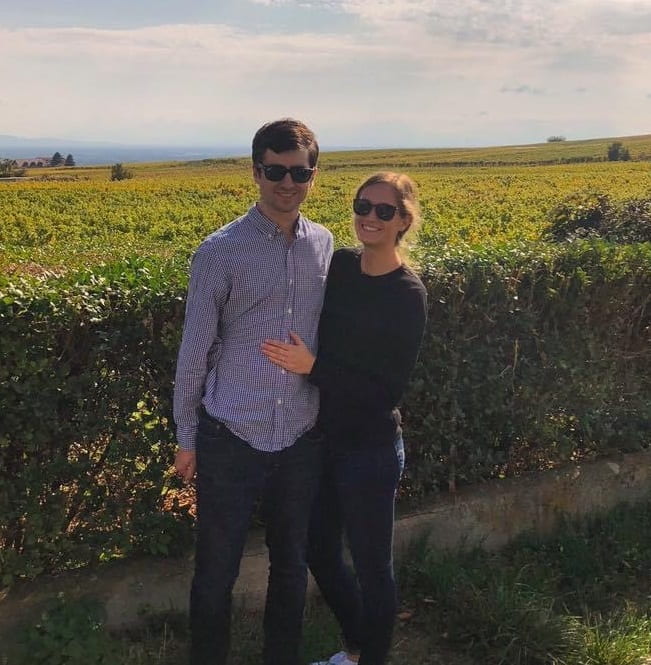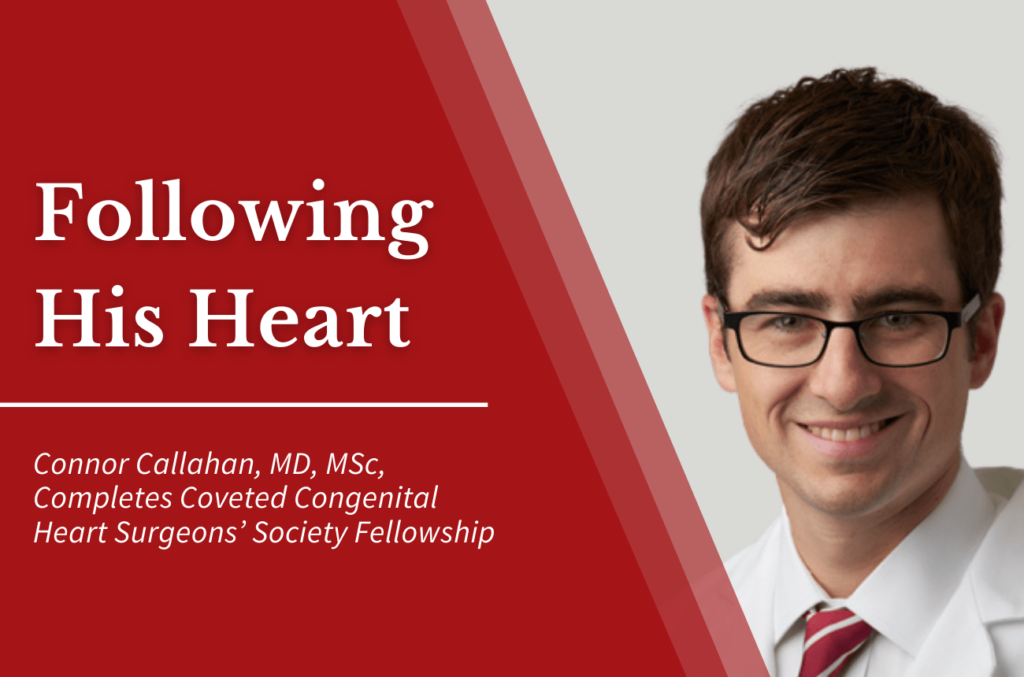With dreams of becoming a pediatric cardiothoracic surgeon, General Surgery resident Connor Callahan, MD, MSc, followed his own heart and seized the opportunity to train as the Congenital Heart Surgeons’ Society (CHSS) John W. Kirklin-David Ashburn Fellow at the Society’s Data Center at the Hospital for Sick Children in Toronto. Callahan is the first Washington University School of Medicine resident to be selected for this coveted fellowship.
The flexibility of his training in the Department of Surgery’s General Surgery Residency program and its supportive faculty and coordinators helped make this decision to take the two-year period away from his clinical training easier. The program’s leaders, shaped by the top minds in surgical education, are thrilled to see their trainees expand their knowledge and expertise during their research periods. The serendipitous timing of the application cycle and his subsequent acceptance all aligned to allow Callahan to begin his research period and move to Toronto for his two-year fellowship.
“Dr. Wise was supportive and understood that this opportunity would be incredibly beneficial to my career,” says Callahan. “The program coordinators helped me get all the required documentation I needed for my application and my Canadian visas.”

Callahan’s first exposure to the fellowship was during his time at the Medical College of Wisconsin when he attended the American Association of Thoracic Surgery’s Annual Meeting through their Member for a Day Program.
“One of the plenary papers of the meeting was presented by the Kirklin-Ashburn fellow at the time,” explains Callahan. “It was an important, expertly delivered paper which was incredibly inspiring to me. Early in my second post-graduate year, Dr. Eghtesady let me know that the fellowship application cycle was opening and encouraged me to apply.”
The CHSS Data Center manages the data sent from up to 80 children’s hospitals in North America. When a child is born with one of the congenital heart lesions of interest (such as atrioventricular septal defects, Ebstein’s anomaly, critical left heart obstruction, pulmonary conduits, anomalous aortic origin of coronary artery, and tricuspid atresia), a coordinator at one of the hospitals prospectively enrolls the patient and sends clinical data to the CHSS Data Center. The Data Center studies this data with hopes of following the children and their conditions through their lifetime. The two-year nonclinical appointment placed Callahan as an integral member of the hospital’s Division of Cardiovascular Surgery.
During his time at the CHSS Data Center, Callahan was responsible for helping manage the database, generating research questions, performing advanced statistical analyses to answer the questions, coordinating working groups of attending pediatric heart surgeons in the studies, submitting and presenting abstracts, and writing research publications. Callahan primarily focused on cases of tricuspid atresia, right ventricle to pulmonary artery conduits and complete atrioventricular septal defects (AVSD).
“Each study we conducted, I led a working group of roughly a dozen surgeons throughout the United States and Canada who provided me valuable feedback for my analyses and helped me write the resulting papers,” says Callahan. “For each of the lesions, we had prospectively enrolled a cohort of patients—ranging from 400 patients for tricuspid atresia and over 700 for atrioventricular septal defects—who we continue to follow and whose data formed the basis of the studies we did.”
Three of those studies, featuring Callahan as their lead author, have been published in two of the specialty’s top academic journals, the Journal of Thoracic and Cardiovascular Surgery and the Annals of Thoracic Surgery.
One study, published in the Journal of Thoracic and Cardiovascular Surgery, investigated the association of atrial septal fenestration after AVSD repair with improved outcomes.
“During biventricular repair of AVSD, sometimes surgeons will place a small hole in the atrial septal portion of their repair,” says Callahan. “Surgeons often do this when they are concerned patients will have a problem in the postoperative period that requires this physiologic ‘pop-off’ to mitigate postoperative morbidity.
“Our question was if fenestration is associated with improved outcomes, but what we actually found was that it was independently associated with increased risk of mortality. With that said, we do not know how much the fenestration directly contributed to that increased mortality risk versus representing a more complex patient population.”
Most recently, Callahan presented research surrounding the outcomes on a subset of patients with ASVD and tetralogy of Fallot (a combination of four defects: ventricular septal defect, pulmonary stenosis, a misplaced aorta and a thickened right ventricular wall) at the Congenital Heart Surgeons’ Society annual meeting in Chicago.

In addition to these distinguished research publications, Callahan added another academic achievement to his repertoire. While working at this fellowship, he earned a Master of Science (MSc) in biostatistics and epidemiology from the University of Toronto.
Although his time in Toronto helped foster Callahan’s research acumen, numerous relationships with international experts in congenital heart surgery, pediatric cardiology and statistics, he missed his friends and family here in St. Louis. COVID-19 related travel restrictions and border closures left him unable to visit for over a year and a half.
“It’s great being back to being a clinically active surgery resident again and I missed my amazing co-residents and working with them when I was away,” says Callahan. “I also missed patient care and operating while I was away, but I will certainly keep research as a key part of my future career.”
In the next year, Callahan hopes to enter the Division of Cardiothoracic Surgery’s combined general and thoracic surgical training fast-track program and will then apply for a congenital cardiac surgery fellowship. Much of his career has already been filled with a variety of fulfilling experiences but his surgical education journey has only just begun.
